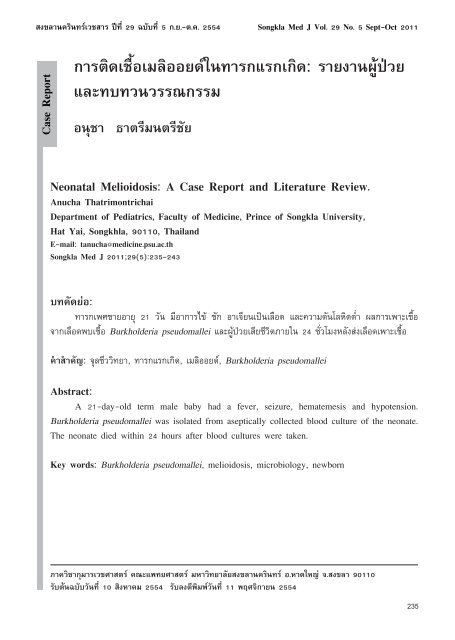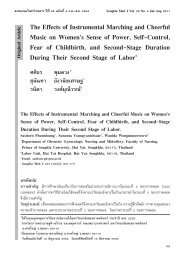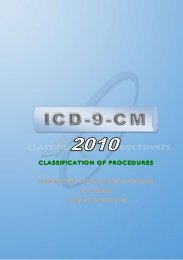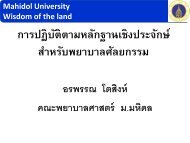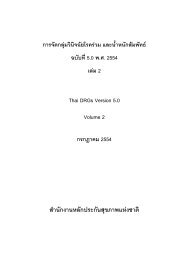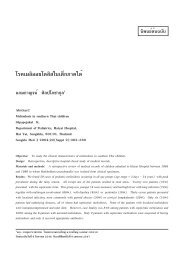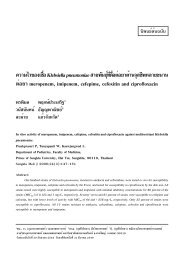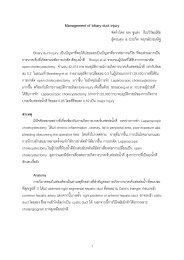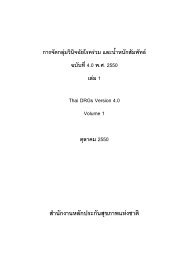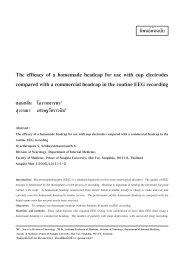A Case Report and Literature Review Anucha Thatrimontrichai ...
A Case Report and Literature Review Anucha Thatrimontrichai ...
A Case Report and Literature Review Anucha Thatrimontrichai ...
You also want an ePaper? Increase the reach of your titles
YUMPU automatically turns print PDFs into web optimized ePapers that Google loves.
ส§¢ÅÒ¹¤ÃÔ¹·Ã์àǪสÒà »‚·Õè 29 ฉบับที่ 5 ก.ย.-ต.ค. 2554 Songkla Med J Vol. 29 No. 5 Sept-Oct 2011<br />
<strong>Case</strong> <strong>Report</strong><br />
การติดเชื้อเมลิออยด์ในทารกแรกเกิด: รายงานผู้ป่วย<br />
และทบทวนวรรณกรรม<br />
อนุชา ธาตรีมนตรีชัย<br />
Neonatal Melioidosis: A <strong>Case</strong> <strong>Report</strong> <strong>and</strong> <strong>Literature</strong> <strong>Review</strong>.<br />
<strong>Anucha</strong> <strong>Thatrimontrichai</strong><br />
Department of Pediatrics, Faculty of Medicine, Prince of Songkla University,<br />
Hat Yai, Songkhla, 90110, Thail<strong>and</strong><br />
E-mail: tanucha@medicine.psu.ac.th<br />
Songkla Med J 2011;29(5):235-243<br />
บทคัดย่อ:<br />
ทารกเพศชายอายุ 21 วัน มีอาการไข้ ชัก อาเจียนเป็นเลือด และความดันโลหิตต่ำา ผลการเพาะเชื้อ<br />
จากเลือดพบเชื้อ Burkholderia pseudomallei และผู้ป่วยเสียชีวิตภายใน 24 ชั่วโมงหลังส่งเลือดเพาะเชื้อ<br />
คำÒสำÒ¤ัญ: จุลชีววิทยา, ทารกแรกเกิด, เมลิออยด์, Burkholderia pseudomallei<br />
Abstract:<br />
A 21-day-old term male baby had a fever, seizure, hematemesis <strong>and</strong> hypotension.<br />
Burkholderia pseudomallei was isolated from aseptically collected blood culture of the neonate.<br />
The neonate died within 24 hours after blood cultures were taken.<br />
Key words: Burkholderia pseudomallei, melioidosis, microbiology, newborn<br />
ภาควิชากุมารเวชศาสตร์ คณะแพทยศาสตร์ มหาวิทยาลัยสงขลานครินทร์ อ.หาดใหญ่ จ.สงขลา 90110<br />
รับต้นฉบับวันที่ 10 สิงหาคม 2554 รับลงตีพิมพ์วันที่ 11 พฤศจิกายน 2554<br />
235
เชื้อเมลิออยด์ในทารกแรกเกิด อนุชา ธาตรีมนตรีชัย<br />
Introduction<br />
Melioidosis is a tropical infectious disease<br />
caused by a Gram-negative, motile, aerobic<br />
bacillus with bipolar staining. It is vacuolated<br />
<strong>and</strong> slender <strong>and</strong> has rounded ends; it is often<br />
described as having a “safety pin” appearance,<br />
Burkholderia pseudomallei. It is endemic to Southeast<br />
Asia <strong>and</strong> northern Australia, <strong>and</strong> cases are<br />
increasingly being reported in countries elsewhere<br />
in Asia, the Pacific, the Americas, the Caribbean,<br />
Africa, the Middle East, <strong>and</strong> Brazil, <strong>and</strong> in travelers<br />
returning from tropical countries. 1,2 To diagnose<br />
melioidosis clinically is difficult as the symptoms<br />
<strong>and</strong> signs are non-specific. It is known as ‘the<br />
great imitator’ to many other diseases. Definite<br />
diagnosis is made when Burkholderia pseudomallei<br />
is isolated from blood, pus, urine or other<br />
sterile body fluids. Almost neonatal melioidosis<br />
is bacteremia. However, the use of cultures is<br />
time consuming, usually taking at least 48 hours<br />
to obtain the result. Many severely ill patients<br />
died before the diagnosis can be established.<br />
This article reported <strong>and</strong> reviewed neonatal<br />
melioidosis literature, caused by Burkholderia<br />
pseudomallei, from 1971 to the present, to address<br />
the mode of transmission, clinical presentation,<br />
laboratory diagnosis, treatment <strong>and</strong> outcome.<br />
<strong>Case</strong> report<br />
A term male baby, appropriate for gestational<br />
age, was born spontaneous vaginal delivery<br />
attended by an unqualified midwife. He weighed<br />
2.5 kg at birth <strong>and</strong> did not receive vitamin K. He<br />
received exclusive breast feeding. He presented<br />
with hematemesis, melena <strong>and</strong> lethargy on the<br />
21 st day of life. He developed high grade fever<br />
236<br />
<strong>and</strong> seizure on right extremities <strong>and</strong> was brought<br />
to the hospital. On examination he was drowsy<br />
<strong>and</strong> had tense anterior fontanel. The pupils were<br />
3 mm in diameter both sides <strong>and</strong> react to light.<br />
There was no sign of menigism. His completed<br />
blood count revealed hematocrit 31%, white blood<br />
cell 8,700 cells/mm 3 <strong>and</strong> platelet 257,000 cells/<br />
mm 3 . The coagulogram was not performed. The<br />
serum electrolyte revealed hyponatremia with<br />
sodium of 118 mEq/l <strong>and</strong> within normal limit of<br />
other electrolyte <strong>and</strong> glucose level. The lumbar<br />
puncture found bloody cerebrospinal fluid without<br />
clotting. The child was provisionally diagnosed<br />
as gastrointestinal <strong>and</strong> intraventricular hemorrhage<br />
from acquired prothrombin complex deficiency<br />
(APCD). He received vitamin K injection, fresh<br />
frozen plasma 10 ml/kg <strong>and</strong> packed red cell<br />
10 ml/kg transfusion, cefotaxime 200 mg/kg/<br />
day, cloxacillin 200 mg/kg/day, phenobarbital<br />
10 mg/kg/day, <strong>and</strong> intravenous fluid to correct<br />
hyponatremia. Ten hour later, he developed apnea<br />
<strong>and</strong> fixed unequal pupils, 1 <strong>and</strong> 3 mm on right <strong>and</strong><br />
left side, respectively. He was intubated <strong>and</strong> put<br />
on dexamethasone. He was then referred to<br />
our hospital on the 23 rd day of life.<br />
The septic workups on arrival revealed<br />
hematocrit 28%, white blood cell 8,000 (b<strong>and</strong><br />
12%), platelet 308,000. The coagulogram was<br />
within normal limit. The emergency computed<br />
tomography (CT) scan of the brain revealed intracerebral<br />
hemorrhage at left temporal area <strong>and</strong><br />
left subdural hemorrhage with shifted midline.<br />
The craniotomy was performed for clot removal<br />
immediately. He was put on 200 mg/kg/day of<br />
cloxacillin injection. The initial blood culture<br />
obtained on the 23 rd day of life revealed methi-<br />
ส§¢ÅÒ¹¤ÃÔ¹·ร์àǪสÒà »‚·Õè 29 ©ºÑº·Õè 5 ก.ย.-ต.ค. 2554
Neonatal Melioidosis <strong>Thatrimontrichai</strong> A.<br />
cillin-susceptible Staphylococcus aureus. Two days<br />
later, he developed hypotension <strong>and</strong> deterioration<br />
of conciousness with a Glasgow Coma Scale<br />
score decrease from 6T to 2T. The repeated CT<br />
scan of the brain revealed cerebral infarction<br />
in the area supplied by middle cerebral artery<br />
<strong>and</strong> brain edema. He died after the 4 th day of<br />
admission or 26 th day of life. The hemoculture<br />
on the 25 th day of life grew Burkholderia pseudomallei<br />
susceptible to augmentin, cefotaxime,<br />
ceftazidime, chloramphenicol, imipenem, tetracycline<br />
<strong>and</strong> sulperazon, but resistant to amikacin,<br />
ampicillin, cotrimoxazole <strong>and</strong> gentamicin. The<br />
source of infection was not found.<br />
Discussion<br />
There were a total of 22 cases reported<br />
of neonatal melioidosis identified in the original<br />
search but the detailed clinical data were available<br />
in only 14 cases. The earliest case was reported<br />
in 1971, <strong>and</strong> the lastest case reported in 2011.<br />
Table 1 summarizes the main features of the 22<br />
reported cases.<br />
In Pahang state of Malaysia, the average<br />
annual incidence rate of melioidosis in children<br />
was found to be 1.6 cases per 100,000 populations.<br />
3 The incidence of neonatal melioidosis<br />
was more predominate in male than in female,<br />
similar to pediatric melioidosis. 4,5 The presence of<br />
specific risk factors for B. pseudomallei infection<br />
may be operating by impairing neutrophil<br />
function, defined virulence factors (including<br />
a type III secretion system) 1 <strong>and</strong> produces a<br />
glycocalyx polysaccharide capsule (biofilm or<br />
slime) that is probably an important virulence<br />
determinant. 6 In adults the most common clinical<br />
manifestation are rapidly progressive pneumonia<br />
<strong>and</strong> septicemia. 7 In children, on the other h<strong>and</strong>,<br />
parotitis <strong>and</strong> infections of the skin <strong>and</strong> lymph node<br />
were more common. 8 In this case, we speculated<br />
that the late-onset B. pseudomallei infection might<br />
have acquired from environmental source either<br />
by inhalation or by direct or indirect contact.<br />
Neurological melioidosis appeared to be<br />
more significant in children (3/8, 37.5%) compared<br />
to adults (6/145, 4.1%). 9 Two cases of neonatal<br />
melioidosis reported had intracranial hemorrhage<br />
diagnosed by autopsy. 10 Our case had intracranial<br />
hemorrhage caused by acquired prothrombin<br />
complex deficiency, diagnosed by no history of<br />
vitamin K injection prophylaxis <strong>and</strong> exclusive<br />
breast feeding, but not clear that intracranial<br />
hemorrhage in this case is related to melioidosis.<br />
In literature review (Table 1), all cases<br />
in neonatal period presented with bacteremia<br />
<strong>and</strong>/or meningitis. The clinical presentations of<br />
neonatal melioidosis were nonspecifically neonatal<br />
sepsis. The common signs <strong>and</strong> symptoms were<br />
fever (15/22, 68.2%), <strong>and</strong> respiratory distress<br />
(tachypnea, grunting, apnea <strong>and</strong> respiratory<br />
failure, 10/14, 71%). Of the 22 reported cases,<br />
10 reported the mode of transmission. Two<br />
cases were investigated <strong>and</strong> identified mother to<br />
child transmission, one case was from vertical<br />
transmission (placental microabscess, case 10)<br />
<strong>and</strong> the other case was from breastfeeding<br />
(case 11). The other eight cases were probably<br />
health care-associated infection <strong>and</strong> probably<br />
community acquired infection equally. Mortality<br />
rate of neonatal melioidosis was extremely high<br />
(16/22, 72.7%), 10-12 whereas death in pediatric<br />
melioidosis had only 0.37-37.5%. 9,13 Mortality in<br />
Songkla Med J Vol. 29 No. 5 Sept-Oct 2011 237
เชื้อเมลิออยด์ในทารกแรกเกิด อนุชา ธาตรีมนตรีชัย<br />
Table 1 Demographic <strong>and</strong> clinical characteristics of 22 documented cases of neonatal melioidosis sorted by year of publication<br />
<strong>Case</strong><br />
Country,<br />
year<br />
Age<br />
at<br />
onset<br />
(days)<br />
PROM<br />
Mode of<br />
delivery<br />
GA<br />
(weeks)<br />
BW<br />
(g)<br />
Mode<br />
of<br />
transmission<br />
Clinical<br />
features<br />
NA,<br />
but<br />
chrioamnionitis<br />
Investigation<br />
Diagnosis<br />
Treatment <strong>and</strong><br />
duration of<br />
antibiotics<br />
therapy<br />
Outcome<br />
1<br />
2<br />
3<br />
4<br />
5<br />
Sex<br />
USA, M<br />
1971 16<br />
Thail<strong>and</strong>, M<br />
1988 10<br />
Thail<strong>and</strong>, F<br />
1988 10<br />
Thail<strong>and</strong>, F<br />
1988 10<br />
Thail<strong>and</strong>, M<br />
1988 10<br />
2<br />
(37 h)<br />
14<br />
14<br />
IAB<br />
IAB<br />
No<br />
No<br />
No<br />
Yes<br />
(1 week)<br />
Forceps<br />
extraction<br />
Forceps<br />
extraction<br />
C/S<br />
due to<br />
placental<br />
previa<br />
totalis<br />
SVD<br />
(criminal<br />
abortion<br />
5 days<br />
before<br />
delivery)<br />
SVD<br />
Term<br />
33<br />
32<br />
32<br />
Preterm<br />
2,977<br />
1,230<br />
1,370<br />
1,340<br />
1,330<br />
NA †<br />
Probably<br />
HCAI<br />
Probably<br />
HCAI<br />
NA<br />
NA<br />
Poor<br />
sucking,<br />
lethargy,<br />
fever,<br />
jaundice,<br />
grunting<br />
Asymptomatic<br />
Respiratory<br />
distress,<br />
apnea,<br />
lethargy<br />
Asymptomatic<br />
Severe<br />
respiratory<br />
distress<br />
NA<br />
WBC6,750<br />
(PMN40%,<br />
B<strong>and</strong>11%)<br />
WBC1,980<br />
(PMN70%,<br />
B<strong>and</strong>17%)<br />
NA<br />
NA<br />
-B. pseudomallei<br />
sepsis <strong>and</strong><br />
meningitis<br />
-Depressed right<br />
frontal skull<br />
fracture<br />
-Pneumonia<br />
-B. pseudomallei<br />
<strong>and</strong> Klebsiella<br />
sepsis<br />
-Twin B, sterile<br />
CSF<br />
-B. pseudomallei<br />
sepsis, sterile CSF<br />
- Omphalitis<br />
-B. pseudomallei<br />
sepsis<br />
-B. pseudomallei<br />
sepsis<br />
-Respiratory<br />
distress syndrome<br />
-Surgery at 3 h<br />
after birth<br />
-Polymyxin B<br />
(parenterally<br />
<strong>and</strong> intrathecally),<br />
9 h<br />
-Cefotaxime<br />
<strong>and</strong> gentamicin,<br />
14 d<br />
-Ceftazidime,<br />
20 d<br />
-Penicillin <strong>and</strong><br />
gentamicin,<br />
10 d<br />
-Penicillin <strong>and</strong><br />
gentamicin,<br />
20 h<br />
Died<br />
(119 h<br />
after<br />
birth)<br />
Recovered<br />
Recovered<br />
Recovered<br />
Died (20<br />
h after<br />
birth)<br />
238<br />
ส§¢ÅÒ¹¤ÃÔ¹·ร์àǪสÒà »‚·Õè 29 ©ºÑº·Õè 5 ก.ย.-ต.ค. 2554
Neonatal Melioidosis <strong>Thatrimontrichai</strong> A.<br />
Table 1 (Continued)<br />
<strong>Case</strong><br />
Country,<br />
year<br />
6 Thail<strong>and</strong>, M<br />
1988 10<br />
7<br />
Malaysia,<br />
1993 17<br />
M<br />
8<br />
Sex<br />
Malaysia, M<br />
1998 18<br />
2001 19<br />
9<br />
Malaysia,<br />
1998 18<br />
M<br />
10<br />
Netherl<strong>and</strong>s,<br />
F<br />
Age<br />
at<br />
onset<br />
(days)<br />
5<br />
2<br />
(30 h)<br />
10<br />
8<br />
2<br />
PROM<br />
Yes (1<br />
week)<br />
NA<br />
No<br />
No<br />
NA<br />
Mode of<br />
delivery<br />
SVD, birth<br />
in a car<br />
SVD<br />
SVD, birth<br />
in an<br />
ambulance<br />
SVD<br />
C/S due<br />
to severe<br />
vaginal<br />
bleeding<br />
GA<br />
(weeks)<br />
Preterm<br />
Term<br />
Term<br />
Term<br />
32<br />
BW<br />
(g)<br />
1,600<br />
3,400<br />
3,200<br />
3,600<br />
1,850<br />
Mode<br />
of<br />
transmission<br />
Probably<br />
HCAI<br />
Probably<br />
HCAI<br />
Probably<br />
communityacquired<br />
Probably<br />
communityacquired<br />
Transmitted<br />
from<br />
mother-tochild<br />
(probably<br />
placental<br />
features<br />
Apnea<br />
Respiratory<br />
distress,<br />
lethargy,<br />
poor feeding<br />
<strong>and</strong> diffuse<br />
macular rash<br />
Clinical<br />
Respiratory<br />
distress,<br />
fever, cough,<br />
lethargy, poor<br />
feeding<br />
Fever,<br />
irritability,<br />
tachypnea,<br />
convulsion<br />
infection) ‡<br />
Respiratory<br />
distress, sepsis<br />
Investigation<br />
NA<br />
WBC6,300<br />
(PMN47%,<br />
B<strong>and</strong>7%)<br />
WBC1,400<br />
Plt.124,000<br />
(CRP>9.6<br />
mg/dl)<br />
WBC<br />
32,800<br />
(PMN83%)<br />
Plt.336,000<br />
(CRP>9.6<br />
mg/dl)<br />
NA<br />
Diagnosis<br />
-B. pseudomallei<br />
meningitis <strong>and</strong><br />
C<strong>and</strong>ida albicans<br />
sepsis<br />
-Pneumonia<br />
-B. pseudomallei<br />
<strong>and</strong> Acinetobacter<br />
sepsis<br />
-Septic shock <strong>and</strong><br />
respiratory failure<br />
from bronchopneumonia<br />
-B. pseudomallei<br />
sepsis<br />
-Septic shock,<br />
bronchopneumonia<br />
-B.pseudomallei<br />
sepsis <strong>and</strong><br />
meningitis<br />
-Pneumonia <strong>and</strong><br />
omphalitis<br />
-B. pseudomallei<br />
sepsis <strong>and</strong><br />
pneumonia<br />
-Right lung abscess<br />
-Placental<br />
microabscesses<br />
Treatment <strong>and</strong><br />
duration of<br />
antibiotics<br />
therapy<br />
-Cefotaxime,<br />
4 h<br />
-Penicillin <strong>and</strong><br />
gentamicin, 1 d<br />
then<br />
-Ticarcillin, 2 d<br />
-Cloxacillin <strong>and</strong><br />
gentamicin<br />
-Cefotaxime <strong>and</strong><br />
gentamicillin,<br />
then<br />
-Ceftazidime,<br />
3 weeks<br />
-Ceftazidime,<br />
8 weeks then<br />
-Amoxicillinclavulanate,<br />
6 weeks<br />
Outcome<br />
Died (9 th<br />
date of<br />
life)<br />
Died (5 th<br />
date of<br />
life)<br />
Died (20 h<br />
after<br />
admission)<br />
Recovered<br />
Recovered<br />
Songkla Med J Vol. 29 No. 5 Sept-Oct 2011 239
เชื้อเมลิออยด์ในทารกแรกเกิด อนุชา ธาตรีมนตรีชัย<br />
Table 1 (Continued)<br />
<strong>Case</strong><br />
Country,<br />
year<br />
11 Australia, M<br />
2004 20<br />
12-19 Thail<strong>and</strong>,<br />
2004 12<br />
NA<br />
20<br />
Malaysia,<br />
2005 21<br />
F<br />
21<br />
Sex<br />
India, F<br />
2009 11<br />
Age<br />
at<br />
onset<br />
(days)<br />
2<br />
NA<br />
8<br />
IAB<br />
PROM<br />
NA<br />
(mastitis<br />
at 2 nd date<br />
before<br />
delivery)<br />
NA<br />
NA<br />
Yes<br />
Mode of<br />
delivery<br />
SVD<br />
NA<br />
SVD, birth<br />
at home<br />
SVD<br />
GA<br />
(weeks)<br />
37<br />
NA<br />
Term<br />
35<br />
BW<br />
(g)<br />
3,020<br />
NA<br />
2,700<br />
1,900<br />
Mode<br />
of<br />
transmission<br />
Transmitted<br />
from<br />
mother-tochild<br />
§<br />
NA<br />
Probably<br />
communityacquired<br />
NA*<br />
Clinical<br />
features<br />
Fever,<br />
tachypnea,<br />
bradycardia,<br />
hypotension<br />
Fever (100%),<br />
peritonitis<br />
(2/8)<br />
Fever,<br />
progressive<br />
abdominal<br />
distension,<br />
vomiting,<br />
lethargy, poor<br />
feeding, pale,<br />
respiratory<br />
distress,<br />
hypotension<br />
Fever,<br />
grunting,<br />
tachypnea,<br />
lethargy, poor<br />
peripheral<br />
perfusion<br />
Investigation<br />
WBC1,900<br />
Plt.18,000<br />
NA<br />
NA<br />
(normal<br />
LFT, CRP><br />
12.8 mg/<br />
dl)<br />
WBC4,500<br />
(normal<br />
LFT)<br />
Diagnosis<br />
-B. pseudomallei<br />
sepsis<br />
-Septic shock <strong>and</strong><br />
respiratory failure<br />
-B. pseudomallei<br />
sepsis<br />
-B. pseudomallei<br />
sepsis <strong>and</strong><br />
pneumonia<br />
-Acute respiratory<br />
distress syndrome<br />
-B. pseudomallei<br />
sepsis<br />
-Bronchopneumonia<br />
Treatment <strong>and</strong><br />
duration of<br />
antibiotics<br />
therapy<br />
-Ampicillin <strong>and</strong><br />
gentamicin<br />
NA<br />
-Cefotaxime (200<br />
mg/kg/day) <strong>and</strong><br />
piperacillin<br />
(200 mg/kg/<br />
day), 2 d then<br />
-Ceftazidime 50<br />
mg/kg/dose<br />
q 12 h<br />
-Ceftriaxone <strong>and</strong><br />
gentamicin,<br />
1 d then<br />
-Ceftazidime <strong>and</strong><br />
vancomycin,<br />
10 d then<br />
-Amoxicillinclavulanate,<br />
2 weeks<br />
Outcome<br />
Died (5 th<br />
date of<br />
life)<br />
All died<br />
(1 st -3 rd<br />
date after<br />
admission)<br />
Died (30 th<br />
date of<br />
life)<br />
Recovered<br />
240<br />
ส§¢ÅÒ¹¤ÃÔ¹·ร์àǪสÒà »‚·Õè 29 ©ºÑº·Õè 5 ก.ย.-ต.ค. 2554
Neonatal Melioidosis <strong>Thatrimontrichai</strong> A.<br />
Table 1 (Continued)<br />
<strong>Case</strong><br />
Country,<br />
year<br />
Sex<br />
Age<br />
at<br />
onset<br />
(days)<br />
PROM<br />
Mode of<br />
delivery<br />
GA<br />
(weeks)<br />
BW<br />
(g)<br />
Mode<br />
of<br />
transmission<br />
Clinical<br />
features<br />
Probably<br />
communityacquired<br />
Investigation<br />
Diagnosis<br />
Treatment <strong>and</strong><br />
duration of<br />
antibiotics<br />
therapy<br />
Outcome<br />
22<br />
Thail<strong>and</strong><br />
(present<br />
case)<br />
M<br />
21<br />
NA<br />
SVD, by<br />
unqualified<br />
midwife<br />
Term<br />
2,500<br />
Fever,<br />
hematemesis,<br />
melena,<br />
lethargy,<br />
seizure<br />
WBC8,700<br />
(PMN51%<br />
B<strong>and</strong>12%)<br />
Plt257,000,<br />
normal<br />
LFT<br />
-B. pseudomallei<br />
<strong>and</strong> methicillinsusceptible<br />
Staphylococcus<br />
aureus sepsis<br />
-Septic shock<br />
-Gastrointestinal<br />
<strong>and</strong> intracerebral<br />
hemorrhage<br />
from acquired<br />
prothrombin<br />
complex deficiency<br />
-Brain herniation<br />
-Cloxacillin (200<br />
mg/kg/day)<br />
Died (26 _<br />
date of<br />
life)<br />
† = Cultures of the mother’s urogenital tract were negative for B. pseudomallei. The father had recent military service in Vietnam, but he had no contact with the infant. The maternal<br />
gr<strong>and</strong>mother had diabetes mellitus.<br />
‡ = On prednisone due to ulcerative colitis <strong>and</strong> had vacation to Thail<strong>and</strong>. Cervical culture showed B. pseudomallei with both IgG <strong>and</strong> IgM enzyme immunoassay were reactive<br />
§<br />
= B. pseudomallei total antibody titer of 1/160 by indirect hemagglutination inhibition with both IgG <strong>and</strong> IgM enzyme immunoassay were reactive<br />
* = Vaginal swab of the mother or environmental samples from the NICU were not recovered B. pseudomallei.<br />
C/S = Cesarean section, CSF = cerebrospinal fluid, F = Female, HCAI = Health care-associated infection, IAB = immediately after birth, M = Male, NA = not available,<br />
PMN = polynuclear neutrophil, Plt = platelet, PROM = premature rupture of membrane, SVD = Spontaneous vaginal delivery, USA = United States of America,<br />
WBC = white blood cell<br />
Songkla Med J Vol. 29 No. 5 Sept-Oct 2011 241
เชื้อเมลิออยด์ในทารกแรกเกิด อนุชา ธาตรีมนตรีชัย<br />
pediatric melioidosis who were bacteremia was<br />
reported to be between 25-80%. 4,14,15 There was no<br />
mortality reported in localized infection 4,14 There<br />
was no report of relapsed infection in survived<br />
newborns <strong>and</strong> some patients were not elucidated.<br />
Burkholderia pseudomallei has unusual<br />
antimicrobial susceptibility patterns. It is resistant<br />
to aminoglycosides except kanamycin, <strong>and</strong> sensitive<br />
to the cefazidine, amoxycillin/clavulanate, <strong>and</strong><br />
carbapenems. There have been no guidelines of<br />
types of antibiotic <strong>and</strong> duration of therapy available<br />
for neonatal melioidosis.<br />
Conclusion<br />
Melioidosis is a rare bacterial infection in<br />
neonates <strong>and</strong> should be considered in the cases<br />
of sepsis. We hope this report alerts general<br />
pediatricians <strong>and</strong> neonatologists, especially in<br />
endemic areas, to consider melioidosis as a<br />
possible cause of sepsis in neonates.<br />
References<br />
1. Cheng AC, Currie BJ. Melioidosis: epidemiology,<br />
pathophysiology, <strong>and</strong> management. Clin<br />
Microbiol Rev 2005; 18: 383 - 416.<br />
2. Rolim DB, Vilar DC, de Goes Cavalcanti LP,<br />
et al. Burkholderia pseudomallei antibodies in<br />
individuals living in endemic regions in Northeastern<br />
Brazil. Am J Trop Med Hyg 2011; 84:<br />
302 - 5.<br />
3. How SH, Ng TH, Jamalludin AR, et al. Pahang<br />
melioidosis registry. Med J Malaysia 2009; 64: 27-<br />
30.<br />
4. How HS, Ng KH, Yeo HB, et al. Pediatric melioidosis<br />
in Pahang, Malaysia. J Microbiol Immunol<br />
Infect 2005; 38: 314 - 9.<br />
5. Suputtamongkol Y, Hall AJ, Dance DA, et al.<br />
The epidemiology of melioidosis in Ubon Ratchatani,<br />
northeast Thail<strong>and</strong>. Int J Epidemiol 1994; 23:<br />
1082 - 90.<br />
6. Steinmetz I, Rohde M, Brenneke B. Purification<br />
<strong>and</strong> characterization of an exopolysaccharide of<br />
Burkholderia (Pseudomonas) pseudomallei. Infect<br />
Immun 1995; 63: 3959 - 65.<br />
7. Chaowagul W, White NJ, Dance DA, et al. Melioidosis:<br />
a major cause of community-acquired<br />
septicemia in northeastern Thail<strong>and</strong>. J Infect<br />
Dis 1989; 159: 890 - 9.<br />
8. Dance DA, Davis TM, Wattanagoon Y, et al.<br />
Acute suppurative parotitis caused by Pseudomonas<br />
pseudomallei in children. J Infect Dis 1989; 159:<br />
654 - 60.<br />
9. K<strong>and</strong>asamy Y, Norton R. Paediatric melioidosis in<br />
North Queensl<strong>and</strong>, Australia. J Paediatr Child<br />
Health 2008; 44: 706 - 8.<br />
10. Lumbiganon P, Pengsaa K, Puapermpoonsiri S,<br />
et al. Neonatal melioidosis: a report of 5 cases.<br />
Pediatr Infect Dis J 1988; 7: 634 - 6.<br />
11. Noyal MJC, Harish BN, Bhat V, et al. Neonatal<br />
melioidosis: a case report from India. Indian J<br />
2009; 27: 260 - 3.<br />
12. Silpapojakul K. Melioidosis in southern Thai<br />
children. Songkla Med J 2004; 22: 363 - 9.<br />
13. Currie BJ, Ward L, Cheng AC. The epidemiology<br />
<strong>and</strong> clinical spectrum of melioidosis: 540 cases<br />
from the 20 year Darwin prospective study. PLoS<br />
Negl Trop Dis 2010; 4: e900.<br />
14. Lumbiganon P, Chotechuangnirun N, Kosalaraksa P.<br />
Clinical experience with treatment of melioidosis<br />
in children. Pediatr Infect Dis J 2004; 23: 1165 - 6.<br />
15. Pagnarith Y, Kumar V, Thaipadungpanit J, et al.<br />
Emergence of pediatric melioidosis in Siem Reap,<br />
Cambodia. Am J Trop Med Hyg 2010; 82: 1106 - 12.<br />
16. Osteraas GR, Hardman JM, Bass JW, et al.<br />
Neonatal melioidosis. Am J Dis Child 1971; 122:<br />
446 - 8.<br />
17. Halder D, Abdullah WA, Johari MR, et al. Neonatal<br />
melioidosis. Singapore Med J 1993; 34: 85 - 6.<br />
242<br />
ส§¢ÅÒ¹¤ÃÔ¹·ร์àǪสÒà »‚·Õè 29 ©ºÑº·Õè 5 ก.ย.-ต.ค. 2554
Neonatal Melioidosis <strong>Thatrimontrichai</strong> A.<br />
18. Halder D, Zainal N, Wah CM, et al. Neonatal<br />
meningitis <strong>and</strong> septicaemia caused by Burkholderia<br />
pseudomallei. Ann Trop Paediatr 1998; 18:<br />
161 - 4.<br />
19. Abbink FC, Orendi JM, de Beaufort AJ. Motherto-child<br />
transmission of Burkholderia pseudomallei.<br />
N Engl J Med 2001; 344: 1171 - 2.<br />
20. Ralph A, McBride J, Currie BJ. Transmission of<br />
Burkholderia pseudomallei via breast milk in<br />
northern Australia. Pediatr Infect Dis J 2004; 23:<br />
1169 - 71.<br />
21. Ang YM. Neonatal meliodosis: very rare but be<br />
aware. Med J Malaysia 2005; 60: 99 - 102.<br />
Songkla Med J Vol. 29 No. 5 Sept-Oct 2011 243


